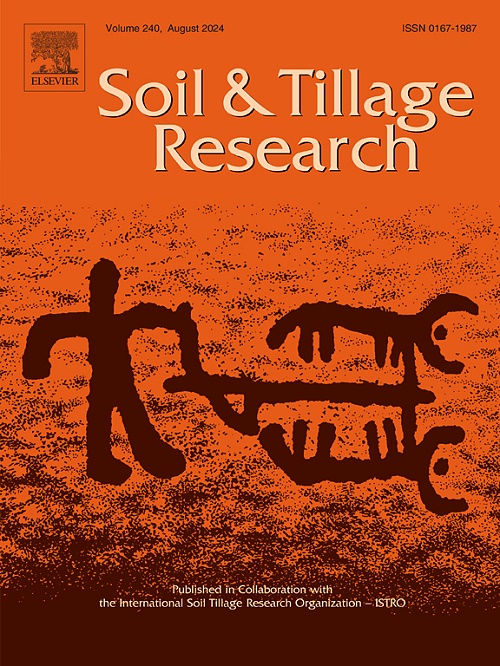Spatio-temporal variations of soil particle size distribution under wind erosion in a temperate grassland: A seven-year landscape scale revisited analysis
IF 6.8
1区 农林科学
Q1 SOIL SCIENCE
引用次数: 0
Abstract
The soil particle size distribution (PSD) is generally perceived as stable as its change by pedogenesis is slow, but it actually undergoes dynamic spatio-temporal changes under the influences of surface processes, especially wind erosion due to its strong sorting effect. In areas with active surface processes like the wind eroded area, PSD dynamically changes (PSDD) as a result of the aeolian erosion and deposition in complementary to the local pedogenesis. Such PSDD is of great importance for understanding soil quality and optimize soil management, however, it is neglected in existing studies. This study analyzed the spatial variability of PSDD and its main influencing factors at depths of 0–1 cm and 1–6 cm in the Xilingele grassland, a typical temperate grassland, using revisited sampling from 2014–2021. The results indicate that in 0–1 cm, the clay increased by 4.76 %, the silt decreased by 1.08 % and the sand decreased by 3.65 %. In 1–6 cm, the clay increased by 2.36 %, the silt increased by 0.18 % and the sand decreased by 1.85 %. Spatial autocorrelation of PSD was moderate in both years, but the spatial heterogeneity decreased from 2014–2021 as dedicated nugget to sill ratio and range. The spatial pattern of PSD showed little temporal variation, with clay content in the 0–1 cm of western steppe and cultivated land increasing more than in mountainous areas, and sand content decreasing more on windward slopes than on flatlands and leeward slopes. The decrease in land use intensity contributed to an increase in clay content in vegetation restoration areas. Wind erosion exhibited a weakening trend in the study area during 2014–2021, but some hot spot areas still experience severe erosion. The decrease in wind erosion is a key factor in the increase in clay content in the region, with land use management contributing to the wind erosion reduction.
温带草原风蚀条件下土壤粒径分布的时空变化特征:基于7年景观尺度的重新分析
土壤粒径分布(PSD)通常被认为是稳定的,因为其受成土作用的影响缓慢,但实际上由于其强大的分选作用,在地表过程,特别是风蚀作用的影响下,PSD发生了动态的时空变化。在风蚀区等地表过程活跃的地区,PSD动态变化(PSDD)是风沙侵蚀和沉积的结果,与当地的成土作用互补。这对了解土壤质量和优化土壤管理具有重要意义,但在现有研究中被忽视。利用2014-2021年重访采样,分析了典型温带草原锡林格勒草原0-1 cm和1-6 cm深度PSDD的空间变异性及其主要影响因素。结果表明:在0 ~ 1 cm范围内,粘土增加4.76 %,粉砂减少1.08 %,砂土减少3.65 %;在1 ~ 6 cm范围内,粘土增加2.36 %,粉砂增加0.18 %,砂土减少1.85 %。2014-2021年,PSD的空间自相关性均为中等,但随着块基比和幅度的增加,空间异质性有所下降。西部草原和耕地0 ~ 1 cm粘土含量增加幅度大于山区,迎风坡沙含量减少幅度大于平原区和背风坡。土地利用强度降低导致植被恢复区粘土含量增加。2014-2021年研究区风蚀呈减弱趋势,但部分热点地区风蚀仍较为严重。风蚀的减少是该地区粘土含量增加的关键因素,土地利用管理有助于减少风蚀。
本文章由计算机程序翻译,如有差异,请以英文原文为准。
求助全文
约1分钟内获得全文
求助全文
来源期刊

Soil & Tillage Research
农林科学-土壤科学
CiteScore
13.00
自引率
6.20%
发文量
266
审稿时长
5 months
期刊介绍:
Soil & Tillage Research examines the physical, chemical and biological changes in the soil caused by tillage and field traffic. Manuscripts will be considered on aspects of soil science, physics, technology, mechanization and applied engineering for a sustainable balance among productivity, environmental quality and profitability. The following are examples of suitable topics within the scope of the journal of Soil and Tillage Research:
The agricultural and biosystems engineering associated with tillage (including no-tillage, reduced-tillage and direct drilling), irrigation and drainage, crops and crop rotations, fertilization, rehabilitation of mine spoils and processes used to modify soils. Soil change effects on establishment and yield of crops, growth of plants and roots, structure and erosion of soil, cycling of carbon and nutrients, greenhouse gas emissions, leaching, runoff and other processes that affect environmental quality. Characterization or modeling of tillage and field traffic responses, soil, climate, or topographic effects, soil deformation processes, tillage tools, traction devices, energy requirements, economics, surface and subsurface water quality effects, tillage effects on weed, pest and disease control, and their interactions.
 求助内容:
求助内容: 应助结果提醒方式:
应助结果提醒方式:


